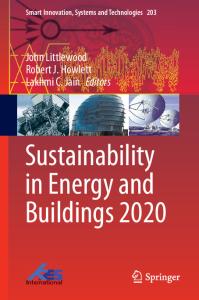Sustainable Materials in Building Construction
This book presents a selection of recent research works that provide best practice solutions, case studies and practical advice on the implementation of sustainable construction techniques. The topics covered include innovations in building sustainability
- PDF / 7,734,867 Bytes
- 168 Pages / 453.543 x 683.15 pts Page_size
- 71 Downloads / 383 Views
J. M. P. Q. Delgado Editor
Sustainable Materials in Building Construction
Building Pathology and Rehabilitation Volume 11
Series Editors Vasco Peixoto de Freitas, University of Porto, Porto, Portugal Aníbal Costa, Aveiro, Portugal João M. P. Q. Delgado
, University of Porto, Porto, Portugal
This book series addresses the areas of building pathologies and rehabilitation of the constructed heritage, strategies, diagnostic and design methodologies, the appropriately of existing regulations for rehabilitation, energy efficiency, adaptive rehabilitation, rehabilitation technologies and analysis of case studies. The topics of Building Pathology and Rehabilitation include but are not limited to - hygrothermal behaviour - structural pathologies (e.g. stone, wood, mortar, concrete, etc…) diagnostic techniques - costs of pathology - responsibilities, guarantees and insurance - analysis of case studies - construction code - rehabilitation technologies architecture and rehabilitation project - materials and their suitability - building performance simulation and energy efficiency - durability and service life.
More information about this series at http://www.springer.com/series/10019
J. M. P. Q. Delgado Editor
Sustainable Materials in Building Construction
123
Editor J. M. P. Q. Delgado CONSTRUCT-LFC, Department of Civil Engineering, Faculty of Engineering University of Porto Porto, Portugal
ISSN 2194-9832 ISSN 2194-9840 (electronic) Building Pathology and Rehabilitation ISBN 978-3-030-46799-9 ISBN 978-3-030-46800-2 (eBook) https://doi.org/10.1007/978-3-030-46800-2 © The Editor(s) (if applicable) and The Author(s), under exclusive license to Springer Nature Switzerland AG 2020 This work is subject to copyright. All rights are solely and exclusively licensed by the Publisher, whether the whole or part of the material is concerned, specifically the rights of translation, reprinting, reuse of illustrations, recitation, broadcasting, reproduction on microfilms or in any other physical way, and transmission or information storage and retrieval, electronic adaptation, computer software, or by similar or dissimilar methodology now known or hereafter developed. The use of general descriptive names, registered names, trademarks, service marks, etc. in this publication does not imply, even in the absence of a specific statement, that such names are exempt from the relevant protective laws and regulations and therefore free for general use. The publisher, the authors and the editors are safe to assume that the advice and information in this book are believed to be true and accurate at the date of publication. Neither the publisher nor the authors or the editors give a warranty, express or implied, with respect to the material contained herein or for any errors or omissions that may have been made. The publisher remains neutral with regard to jurisdictional claims in published maps and institutional affiliations. This Springer imprint is published by the registered company Springer Nature Switzerland AG The registered company a
Data Loading...











